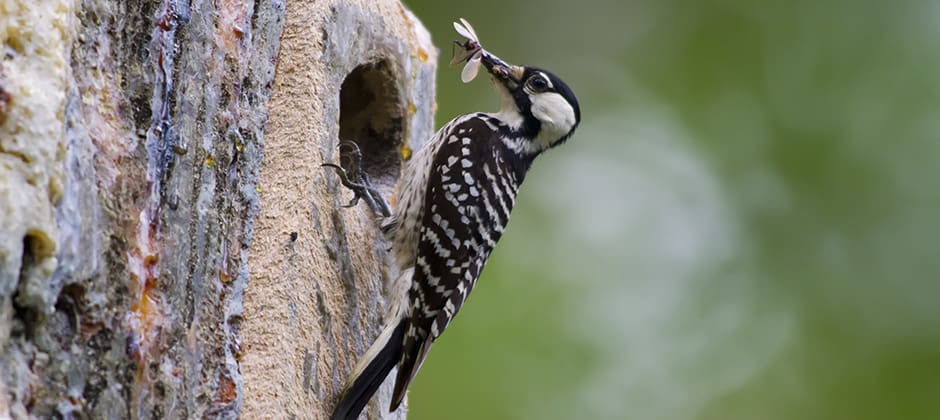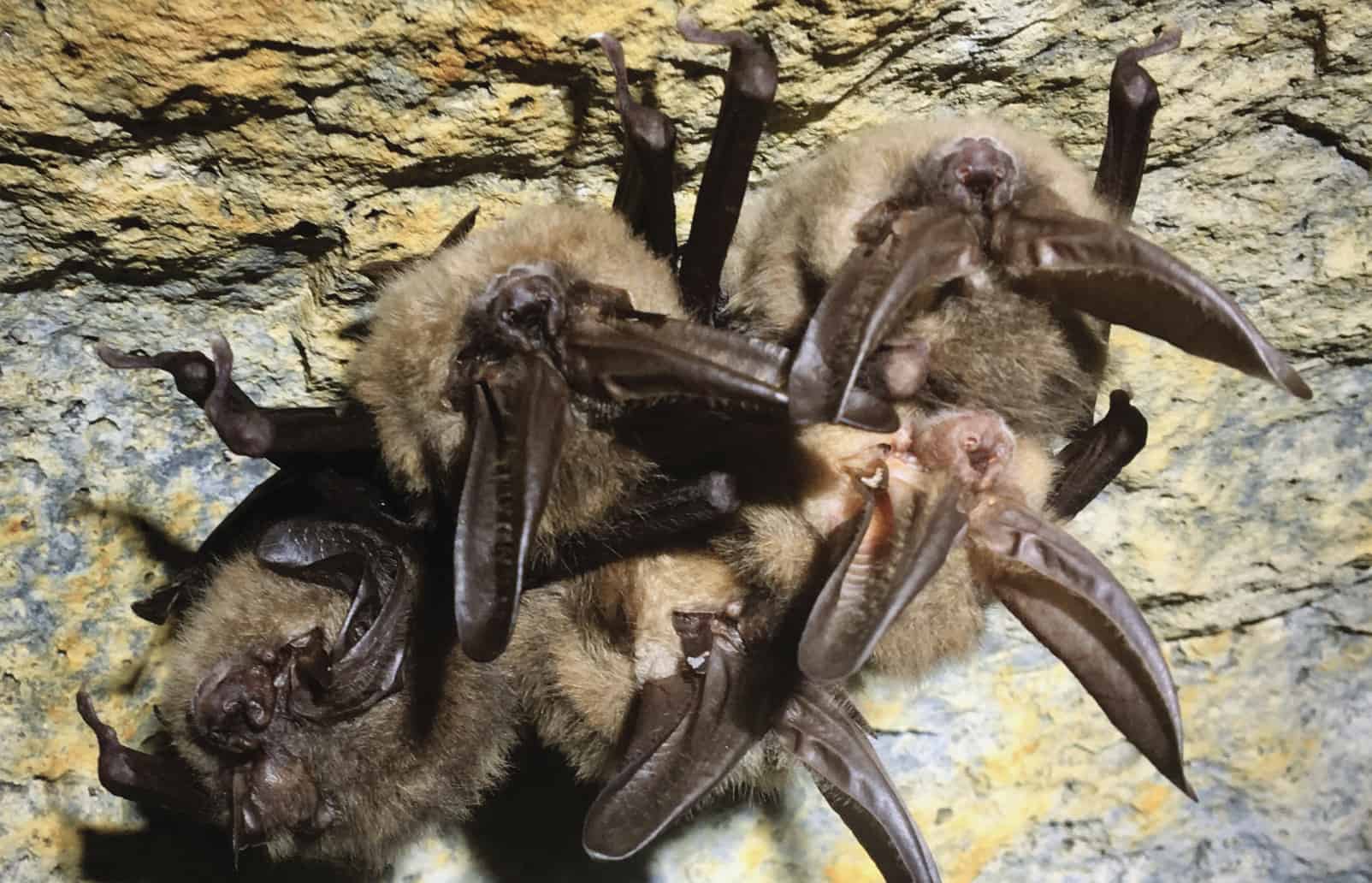Share this article
For rebounding woodpecker, success depends on humans
For millennia, fire helped red-cockaded woodpeckers thrive in the South’s longleaf pine forests. The flames cleared the forest understory that predators could use to access woodpecker nests, which the birds establish in hollows they peck out of the trees.
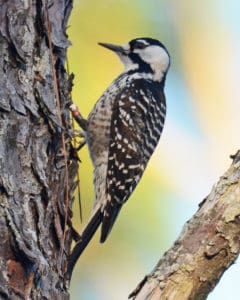
Red-cockaded woodpeckers thrive in longleaf pine forests. ©Jeremy Cohen
But over the past century, humans reduced wildfires, which posed dangers to people’s lives and property even though they created optimal conditions for the birds. Humans also logged or removed much of the longleaf pine forest. Today, red-cockaded woodpeckers (Picoides borealis) occupy just 3% of their original range. The birds are listed as endangered by the U.S. Fish and Wildlife Service, although that status is being reconsidered as the birds rebound.
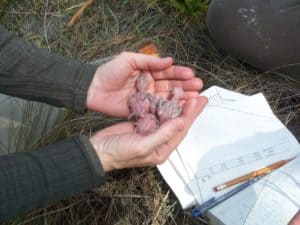
Red-cockaded woodpecker chicks are usually cooperatively raised by parents and other birds that nest nearby. ©Shayne Banks/BLM
In some areas, however, efforts to increase the woodpeckers’ numbers are stalling. Despite a recovery plan objective of 394 groups, conservation efforts to boost the population in Talladega National Forest in Alabama hit a plateau at 123 clusters of woodpeckers, said TWS member Paige Ferguson, an assistant biology professor at the University of Alabama.
She and her co-authors of a study published recently in the Journal for Nature Conservation wanted to see what management methods worked best to increase red-cockaded woodpeckers in a section of the forest and how they could do it while improving forest health, recreation opportunities and other stakeholder goals.
Prescribed burns, they found, could meet all of their goals. The natural fire regime created ideal conditions for the woodpeckers, Ferguson found. The birds prefer to nest in trees surrounded by open understory, without nearby vegetation that give predators like rat snakes easier access to their nests.
Forest managers had been doing prescribed burns in Talladega for a while, though. So why did woodpecker numbers plateau far beneath population goals?
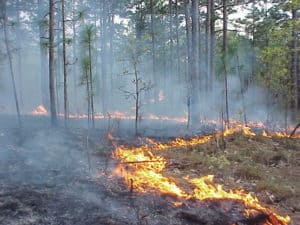
Fort Bragg in North Carolina adopts an aggressive red-cockaded woodpecker habitat management and forest enhancement program focused on pine stand thinning, hardwood mid-story control and growing season prescribed fires. ©Forestry Branch, Fort Bragg
The problem, Ferguson said, is that it can take red-cockaded woodpeckers years to create their nest hollows, which, unlike other woodpeckers, they prefer to peck out of living trees. “That’s a lot harder, and it takes a lot more time than it does in a dead tree,” Ferguson said.
Complicating matters, the birds tend to prefer older trees, especially those infected by red heart rot, said Robert Abernethy, president of The Longleaf Alliance. This fungus damages the center of longleafs and softens the wood, making it easier for the birds to burrow into. Red-cockaded woodpeckers will often scout for trees afflicted with this fungus, but it is unknown how they determine if a tree has red heart.
Many areas formerly dominated by larger longleaf pines are now predominantly made up of loblolly pines, Abernethy said, since the timber industry favors these faster growing trees. Logging outfits will also harvest both loblollies and longleafs before they are old enough for the woodpeckers to make nests. Other limiting factors include hurricanes — recent storms like Hurricane Michael or Hugo have snapped a number of trees ideal for the woodpeckers in the Southeast.
Red-cockaded woodpeckers often take years to peck out new homes in multi-generational excavation efforts. Cooperative breeders, they typically need a cluster of old pine trees with hollows appropriate for nesting. If their nests are snapped by a hurricane, surviving birds have to relocate, Abernethy said, sometimes forcing them into open roosts where they are susceptible to bad weather and predators.
Conservationists have responded by boring nest inserts into the sides of trees. This cavity installation was the best strategy they looked at to help the birds, Ferguson found. Many red-cockaded woodpeckers in the wild currently occupy human-built nest cavities, Abernethy said, which have helped the birds but are “a big limiting factor” in the woodpeckers’ recovery. Without them, he said, the woodpeckers have limited options for nesting.
Whether restoring natural burn cycles, carving out nests or returning longleaf pines to the ecosystem, conservation efforts have started to pay off, Abernethy said, and they’ve benefited other species, like federally endangered dusky gopher frogs (Lithobates sevosus) and gopher tortoises (Gopherus polyphemus), which are listed as endangered west of the Mobile River. Still, just over 5% of the historical longleaf pine ecosystem remains, he said.
The U.S. Fish and Wildlife Service released a three-year plan in April that proposes changing the status of the woodpeckers — one of the first species to be listed under the Endangered Species Act — to threatened or recovered.
“They’re coming back,” Abernethy said, but without prescribed fires, and the protection afforded by extension to the longleaf pine trees they nest in due to their current listing, continued success may not happen.
“They are heavily dependent on human beings to put inserts in and heavily dependent on humans to prescribe burns,” Abernethy said.
“Downlisting may be warranted. It will be interesting to see what the public comment period yields. But I would be surprised if the delisting of this species that is totally dependent on active wildlife management in the form of prescribed fire, cavity excavation, and longer timber rotations is determined to be warranted,” he said.
Header Image: The U.S. Fish and Wildlife Service is considering downlisting federally threatened red-cockaded woodpeckers. ©USFWS



